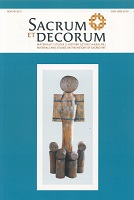Wątki mesjanistyczne i martyrologiczne w Bożych Grobach kościołów poznańskich w latach 1982–1985 jako przyczynek do dyskusji nad zjawiskiem aranżacji wielkotygodniowych
Messianic and martyrological themes of Christ’s Tombs in Poznań churches in the years 1982–1985: a contribution to the research on Holy Week decorations
Author(s): Leszek MakówkaContributor(s): Grażyna Ryba (Editor)
Subject(s): History, Fine Arts / Performing Arts, Theology and Religion
Published by: Wydawnictwo Uniwersytetu Rzeszowskiego
Keywords: Christ’s Tomb; Passion; contemporization; martyrology; messianism; instrumentalization; independent culture; church; Poznań; Martial Law; social-political situation; religious art
Summary/Abstract: Developing since the Partitions, Polish messianism always strengthened in the periods when the Polish state and the existence of the Polish nation were threatened. In the first half of the 1980s, this tradition, intensified after the proclamation of Martial Law, found its expression in the Easter compositions of Christ’s Tomb. These arrangements constituted an independent, typically Polish phenomenon, joining the liturgical tradition with the national martyrology. The traditional motifs of Holy Week decorations were thus enriched with objects and symbols related to the contemporary social and political situation. In large cities, the compositions were also built by professional artists from the circles of Independent Culture. In this article, to exemplify this phenomenon, Christ’s Tombs from Poznań churches in the years 1982–1985 are presented. By subjecting those compositions to artistic critique, it is hypothesized that the analysed works nevertheless escape the application of the traditional art-historian’s tools, and that they constitute a unique phenomenon that must also be analysed from other research perspectives. The custom of building Christ’s Tombs is also discussed in the context of European religious art inspired by Paschal themes in the second half of the 20th century. Kształtujący się od czasów rozbiorów mesjanizm polski przybierał na sile w okresach zagrożenia polskiej państwowości i egzystencji narodu. W 1. połowie lat 80. ubiegłego wieku artystycznym przejawem tej tradycji, zintensyfikowanej po wprowadzeniu stanu wojennego, były aranżacje Bożych Grobów, stanowiące odrębne, typowo polskie zjawisko łączące tradycje liturgiczne z martyrologią narodową. W tradycyjne motywy dekoracji wielkotygodniowej, tworzonej w większych miastach także przez artystów z kręgu Kultury Niezależnej, wplatano rekwizyty i symbole odnoszące się do aktualnej sytuacji społecznej i politycznej. Jako egzemplifikacja zjawiska zostały przywołane Boże Groby z poznańskich kościołów lat 1982–1985. Poddając te realizacje krytyce artystycznej, autor artykułu stawia tezę, że rozpatrywane zjawisko wymyka się jednak narzędziom stosowanym przez tradycyjną historię sztuki i jest swoistym fenomenem, który należy analizować także z innych pespektyw badawczych. Zwyczaj budowania Bożych Grobów omówiony został także w kontekście europejskiej sztuki religijnej inspirowanej wątkami pasyjnymi w 2. połowie XX wieku.
Journal: Sacrum et Decorum. Materiały i studia z historii sztuki sakralnej
- Issue Year: 2015
- Issue No: 8
- Page Range: 128-138
- Page Count: 11
- Language: English, Polish

